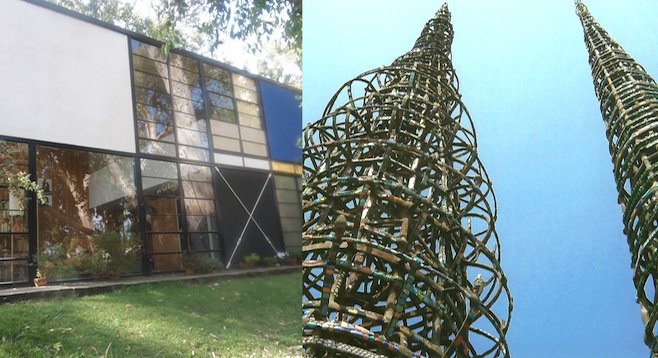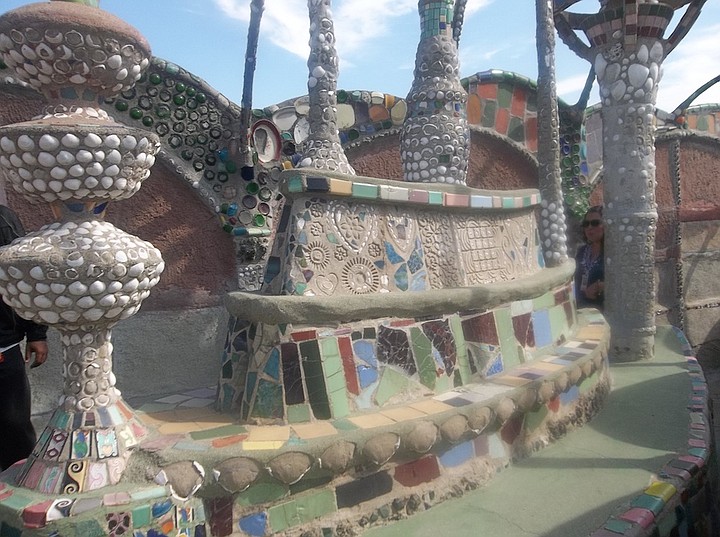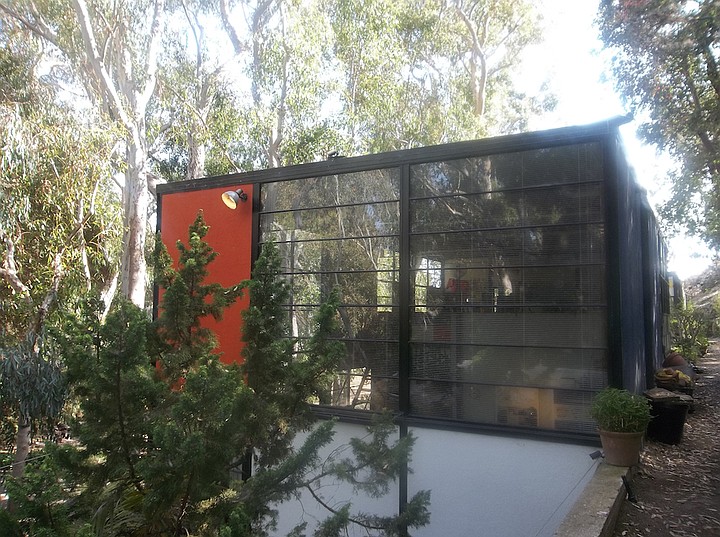 Facebook
Facebook
 X
X
 Instagram
Instagram
 TikTok
TikTok
 Youtube
Youtube

I braved Carmageddon II on a September Saturday and visited L.A. to explore the individual creations of two iconoclastic L.A. visionaries. Located in vastly different sections of L.A., the Watts Towers and Eames House represent the gamut of the creative spirit in Los Angeles.
The Watts Towers
“I had it in my mind to do something big and I did,” Simon Rodia succinctly summed up his feeling about his life’s crowning achievement, the Watts Towers.
His astounding creation is one of those spots I always intended to – but never did – visit when I lived in L.A.
When I recently discovered that most of my friends had never heard of the structure, I decided to make the two-hour trek there from San Diego. The neighborhood is sketchy, but signs conveniently lead you there once you exit the freeway.
Rodia’s story is one of the all-time classic immigrant stories. He came to the U.S. from Italy and became employed as a tilemaker in Los Angeles, subsequently buying some cheap property in what is now the Watts area. Inspired by his love of builders and explorers, Rodia began his creation, doggedly devoting his nights, weekends and holidays over the course of 33 years to fulfilling his dream. The result is one of the most astonishing structures in Los Angeles and one which displays a singular vision.
A feeling of awe engulfed me as I looked up at the Towers. The bell towers and gothic cathedrals of Rodia’s Italian childhood are reflected in the 99-foot high structures. If they had exceeded 100 feet, Rodia would have had to obtain a permit, and he did not want to invite harassment from city officials.

Colorful, detailed mosaic decorations surrounding the spires of reinforced concrete are particularly impressive when viewed up close (left). The towers are constructed of a steel core wrapped in wire mesh. They are covered with mortar, and inlaid with a variety of materials that Rodia collected, including tile, glass, shell, pottery, ceramics and rocks. On my visit, a child, studying the materials used, pointed out green shards of old 7-Up bottles.
The Towers consist of seventeen sculptures and are intended to follow the structural principles found in nature. They were built without bolts, rivets, welds or drawing board designs. Rodia climbed the structures, completing them a layer at a time using simple tools, pipe fitters and a window washer’s belt and buckle. He did not use scaffolding or ladders. The man must have had nerves of steel to hang from the top sections of the towers (and was fortunate he never fell to his death), working to complete his beloved project well into his seventies.
The central spot of the site is the gazebo where Rodia performed weddings, even though he was not an ordained minister. He never did learn how to read or write in English or Italian. A huge decorated fountain adjoining the gazebo is shaped like a wedding cake.

Rodia considered himself an explorer in the mold of Marco Polo, and the entire project can be considered a metaphor for a ship. The walls that frame the towers (left) are shaped like a ship. The towers themselves represent the sails of the ship and there is even a drawing of the waterline.
An effort to save the Towers by two local artists was successful after they were condemned to be demolished in 1957. The Towers, however, are again in a precarious financial situation due to budget cutbacks. Funding for needed upkeep is an ongoing struggle for those who advocate for the preservation of the structure.
The guide I met lauded the efforts of the Director of the Watts Towers, Rosie Lee Hooks. “She’s a fighter for us, but the necessary funds for upkeep are still touch and go from month to month.”
The day of my visit coincided with the 31st-annual Day of the Drum and Jazz Festival, held annually on the last weekend in September. Music and drumming performances, arts and crafts, and international foods are all featured during the two-day event.
The Eames House
The Eames House, also known as Case Study #8, was designed by Charles Eames and Eero Saarinen in 1945. It is located off quiet Chautauqua Street in Pacific Palisades. The home can only be viewed from the exterior and via a two-day advance reservation.
Charles Eames and his wife, Ray, moved into the house in 1949 and lived there for the rest of their lives. The couple used it as a base for a multitude of artistic projects that they collaborated on, including designs of furniture, films and even toys.

The Eames House is pleasantly situated amid a grove of eucalyptus trees, adjoining a meadow that provides a sweeping view of the Pacific. The feeling of the property is one of serenity and solitude, a perfect atmosphere for creative experimentation and expression – a house in which to work as well as play. The Eames House seems to float above the meadow, so as to be in harmony with it.
The Getty Conservation Institute has a 250-year plan for preservation. The research on long-term preservation of the steel-and-glass structure will provide architecture lovers on L.A.'s Westside some comfort, considering the home’s precarious proximity to the coast. With $250,000 pledged to preserve the Eames House into perpetuity, it enjoys a substantially better financial cushion for upkeep than the Watts Towers.
A docent is available to provide general information, collect the $10 admission fee, and answer questions. You're then free to take a self-guided tour around the grounds.


I braved Carmageddon II on a September Saturday and visited L.A. to explore the individual creations of two iconoclastic L.A. visionaries. Located in vastly different sections of L.A., the Watts Towers and Eames House represent the gamut of the creative spirit in Los Angeles.
The Watts Towers
“I had it in my mind to do something big and I did,” Simon Rodia succinctly summed up his feeling about his life’s crowning achievement, the Watts Towers.
His astounding creation is one of those spots I always intended to – but never did – visit when I lived in L.A.
When I recently discovered that most of my friends had never heard of the structure, I decided to make the two-hour trek there from San Diego. The neighborhood is sketchy, but signs conveniently lead you there once you exit the freeway.
Rodia’s story is one of the all-time classic immigrant stories. He came to the U.S. from Italy and became employed as a tilemaker in Los Angeles, subsequently buying some cheap property in what is now the Watts area. Inspired by his love of builders and explorers, Rodia began his creation, doggedly devoting his nights, weekends and holidays over the course of 33 years to fulfilling his dream. The result is one of the most astonishing structures in Los Angeles and one which displays a singular vision.
A feeling of awe engulfed me as I looked up at the Towers. The bell towers and gothic cathedrals of Rodia’s Italian childhood are reflected in the 99-foot high structures. If they had exceeded 100 feet, Rodia would have had to obtain a permit, and he did not want to invite harassment from city officials.

Colorful, detailed mosaic decorations surrounding the spires of reinforced concrete are particularly impressive when viewed up close (left). The towers are constructed of a steel core wrapped in wire mesh. They are covered with mortar, and inlaid with a variety of materials that Rodia collected, including tile, glass, shell, pottery, ceramics and rocks. On my visit, a child, studying the materials used, pointed out green shards of old 7-Up bottles.
The Towers consist of seventeen sculptures and are intended to follow the structural principles found in nature. They were built without bolts, rivets, welds or drawing board designs. Rodia climbed the structures, completing them a layer at a time using simple tools, pipe fitters and a window washer’s belt and buckle. He did not use scaffolding or ladders. The man must have had nerves of steel to hang from the top sections of the towers (and was fortunate he never fell to his death), working to complete his beloved project well into his seventies.
The central spot of the site is the gazebo where Rodia performed weddings, even though he was not an ordained minister. He never did learn how to read or write in English or Italian. A huge decorated fountain adjoining the gazebo is shaped like a wedding cake.

Rodia considered himself an explorer in the mold of Marco Polo, and the entire project can be considered a metaphor for a ship. The walls that frame the towers (left) are shaped like a ship. The towers themselves represent the sails of the ship and there is even a drawing of the waterline.
An effort to save the Towers by two local artists was successful after they were condemned to be demolished in 1957. The Towers, however, are again in a precarious financial situation due to budget cutbacks. Funding for needed upkeep is an ongoing struggle for those who advocate for the preservation of the structure.
The guide I met lauded the efforts of the Director of the Watts Towers, Rosie Lee Hooks. “She’s a fighter for us, but the necessary funds for upkeep are still touch and go from month to month.”
The day of my visit coincided with the 31st-annual Day of the Drum and Jazz Festival, held annually on the last weekend in September. Music and drumming performances, arts and crafts, and international foods are all featured during the two-day event.
The Eames House
The Eames House, also known as Case Study #8, was designed by Charles Eames and Eero Saarinen in 1945. It is located off quiet Chautauqua Street in Pacific Palisades. The home can only be viewed from the exterior and via a two-day advance reservation.
Charles Eames and his wife, Ray, moved into the house in 1949 and lived there for the rest of their lives. The couple used it as a base for a multitude of artistic projects that they collaborated on, including designs of furniture, films and even toys.

The Eames House is pleasantly situated amid a grove of eucalyptus trees, adjoining a meadow that provides a sweeping view of the Pacific. The feeling of the property is one of serenity and solitude, a perfect atmosphere for creative experimentation and expression – a house in which to work as well as play. The Eames House seems to float above the meadow, so as to be in harmony with it.
The Getty Conservation Institute has a 250-year plan for preservation. The research on long-term preservation of the steel-and-glass structure will provide architecture lovers on L.A.'s Westside some comfort, considering the home’s precarious proximity to the coast. With $250,000 pledged to preserve the Eames House into perpetuity, it enjoys a substantially better financial cushion for upkeep than the Watts Towers.
A docent is available to provide general information, collect the $10 admission fee, and answer questions. You're then free to take a self-guided tour around the grounds.
Comments